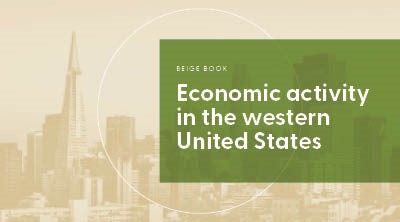We produce a wide range of publications that share the latest data, analysis, and insights from various teams at the SF Fed. Our publications help inform and strengthen public understanding of economic issues and its impact on people and communities.

Economic Research Publications
FRBSF Economic Letter >
Economic analysis for general audiences
-

Dynamic Central Bank Communication
Central banks have a responsibility to share information in ways that improve the public’s understanding. This communication must be consistent enough that people can follow, and dynamic enough that it can adjust to the circumstances that are faced. Federal Reserve communications over the past 30 years have evolved to become significantly more transparent. The following is adapted from remarks presented by the president of the Federal Reserve Bank of San Francisco at the Western Economic Association International 100th Annual Conference in San Francisco on June 22.
SF FedViews >
Analysis of current economic developments and the outlook
-

SF FedViews: June 5, 2025
Daniel Wilson, vice president at the Federal Reserve Bank of San Francisco, stated his views on the current economy and the outlook as of June 5, 2025.
Working Papers >
The latest in economic research
-

Asset Purchases in a Monetary Union with Default and Liquidity Risks
Using a two-country monetary union framework with financial frictions, we quantify the efficacy of targeted asset purchases, as well as expectations of such programs, in the presence of sovereign default and financial liquidity risks. The risk of default increases with the level of government debt and shifts in investors’ perception of fiscal solvency. Liquidity risks […]
Community Engagement and Analysis Publications
Community Development Research Briefs >
Research briefs feature data and commentary on community development trends and issues.
-
Homeownership Opportunities Beyond Single-Family: Quantifying the Current Landscape
Although homeownership is commonly portrayed as a single household living in a detached house, homeownership in the U.S. includes an array of opportunities, some of which provide more affordable entry points into owning a home.
Community Development Working Papers >
Working papers provide in-depth analysis of emerging community development issues from practitioners and scholars.
-
Housing Market Interventions and Residential Mobility in the San Francisco Bay Area
Limited evaluation research exists on which housing solutions are most effective in stabilizing communities so that those who wish to stay are able to do so in the midst of an influx of newcomers. This study seeks to fill this gap by assessing patterns of individual and household mobility related to specific housing interventions in the nine-county San Francisco Bay Area. Specifically, this study examines impacts of market-rate and subsidized development, and tenant protections, including rent stabilization and just cause for evictions protections.


